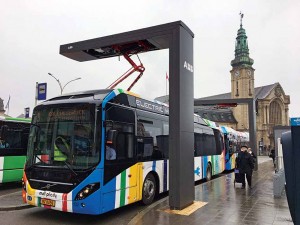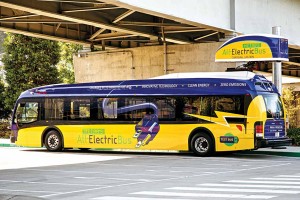New charging methods including opportunity charging strategies are making electric buses attractive.
Team CV
Electric buses are still in their infancy. They are however inevitable. Supported by technology, they are progressing at a serious rate. Even the technology to charge bus batteries is changing. Operators are coming to have more than one method to charge their vehicles. The new methods do away with ‘overnight charging’, which has traditionally been the technique. The traditional ‘plugged in’ charging method is known to require several hours of charging to hit the road with a fully charged battery. Something that is difficult to repeat each day. An alternative method of opportunity charging – a rapid and intense blast of power at strategic points along the route is turning out to be promising. It is also showing the potential to have a longer range as well.
At Auto Expo 2016, JBM Solaris displayed a 9 m electric bus called the Ecolife. The bus flaunted a pantograph apart from the option of plug-in charging system. Equipped with fast charging Lithium batteries, the bus, according to Dr. Andreas Strecker, CEO, Solaris Bus & Coach S.A., is capable of running 150-200 kms in 10 to 15 hours of city bus operation. The pantograph rapid charging technology, said Strecker, was developed in association with ABB. Working such that the pantograph ‘plugs-in’ at every stop the bus takes, the technology, according to Daan Nap, Global Sales Director for electric bus charging, at ABB, there is much difference between the traditional method of charging and what his company is offering. “On an average [a bus] might drive 100 or 200 miles a day, so you take a very big battery, charge the bus overnight, drive around all day, and at night, you charge it again. Such overnight charging means quite big batteries of 200 or 300kWh for example, and a charging process that happens at probably 50kW or 80kW over four, five or six hours.” “Bigger batteries add to the weight of the bus, and compromise its efficiency, said Daan. He averred, “People say that the battery is big and heavy. It takes up a lot of space, and has an effect on passenger carrying capacity as well as the travel range.”
In case of the traditional method of charging, weight and range turn out to be a limiting factor for bus application. The pantograph method provides a good opportunity for an operator who is looking at covering 300 to 400 miles a day. Mentioned Nap, “The vehicle (in case of opportunity charging) is the same, and employs a smaller battery since there’s a charging system at the end point of each route. That’s at the point where, normally, the bus is empty, and the passengers have got out. Also, there’s a break of five or 10 minutes.” “The charging is done at higher power – at a level of around 300 or 450kW. The batteries on the bus charge quickly. In a span of three to six minutes. The bus can run the route again – one, two, three or four times. By doing so, the size of the battery can be reduced, and also the weight and cost. The bus can carry more passengers,” Nap explained. Interestingly, opportunity charged buses typically lend themselves to longer routes that are out of the reach of overnight charge vehicles. According to Adrian Felton, City Mobility Manager, Volvo Buses, electric hybrid opportunity charge buses make sense on routes that involve a mixture of inner and outer city driving. “Say the route is 20-30 km long; electric hybrid opportunity charge buses are ideally suited,” he adds. There’s an efficient hybrid vehicle running for 20 km. It could be zone-managed so that the two km of initial running is done in pure electric mode. The other five km could be used by the bus in the city centre, improving the quality of air.
A big advantage of opportunity charging is the ability to geo-fence or zone-manage. It is possible to set up a vehicle, and to agree upon specific areas of operation with the operators or authorities. Fully automatic, this is perhaps one of the first stages that will aid the move up to autonomous operations. Zone management is done through GPS. There are three types of zones, and the vehicle can operate with zero emissions. It can also be set to operate in a silent mode by shutting down some of the ancillaries like AC. Even safety zones in a specific area can be drawn to reduce the vehicle’s speed. Opportunity charging, interestingly, suits short-cycle, repetitive routes. The best use case for opportunity charging, according to Matt Horton, Chief Commercial Officer, Proterra, is under situations like airports where the buses follow the same route for hours. These are usually short routes, he stated. For en-route charging, dense urban areas, downtown or airport-style circulator routes tend to be make a lot of sense. Volvo’s opportunity charging system for example uses an overhead mast to power up the bus from the top down. The vehicle pulls over under the mast, and there is a marker on the roadside. There is quite a lot of leeway in the rails and the charging mast so that it doesn’t have to be within millimetres. The vehicle locates the mast, and positions itself. The driver applies the handbrake. A message on the dash lights up, saying ‘ready to charge’. The charger comes down, and tops up the battery. Once complete, the indication says ‘fully charged’. The driver releases the parking brake, and the charger disconnects automatically. Until the pantograph has fully retracted, the vehicle does not move away.
In case of longer downtime, the amount of charging infrastructure can be cut down. This is especially true for routes that have evolved over a longer period of down time. With the use of opportunity charging, if there’s an opportunity to park and ride, and the layover time is between five and seven minutes, one piece of charging infrastructure on a longer route may suffice. About seven minutes of layover time means a vehicle can travel to the city centre and back without the need of any infrastructure. For a network spread over a good distance, the need will be to place strategic infrastructure at bus interchanges. Technology is continuing to evolve. Opportunity charging is looking promising, and could provide a promising alternative to overnight charging. The need of the time is to make en-route charging technology and infrastructure cost effective. There is a need for it to be competitive in comparison to the traditional methods of charging. Chargers used in traditional, overnight, charging technologies are rapidly dropping down in prices. Battery prices too have dropped almost 75 per cent in the last four-to-five years. Much transformation is on.

Invigning av ABB laddstation för bussar. Samarbete med Volvo.
Foto: Anna Rehnberg























